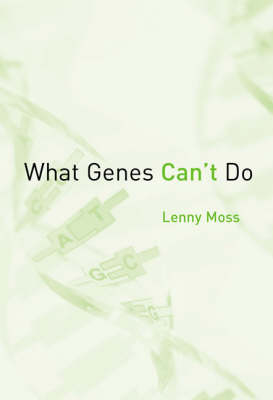
What Genes Can't Do
Seiten
2002
Bradford Books (Verlag)
978-0-262-13411-8 (ISBN)
Bradford Books (Verlag)
978-0-262-13411-8 (ISBN)
- Titel ist leider vergriffen;
keine Neuauflage - Artikel merken
The idea of the gene has been a central organizing theme of 20th-century biology, and the Human Genome Project and biotechnological advances have put the gene in the media spotlight. This work reviews the history that led to the gene-centered approach of contemporary biology.
The idea of the gene has been a central organising theme in contemporary biology, and the Human Genome Project and biotechnological advances have put the gene in the media spotlight. In this book Lenny Moss reconstructs the history of the gene concept, placing it in the context of the perennial interplay between theories of preformationism and theories of epigenesis. He finds that there are not one, but two, fundamental - and fundamentally different - senses of "the gene" in scientific use: one the heir to preformationism and the other the heir to epigenesis. "Gene-P," the preformationist gene concept, serves as an instrumental predictor of phenotypic outcomes, whereas "Gene-D," the gene of epigenesis, is a developmental resource that specifies possible amino acid sequences for proteins. Moss argues that the popular idea that genes constitute blueprints for organisms is the result of an unwarranted conflation of these independently valid senses of the gene, and he analyses the rhetorical basis of this conflation. In the heart of the book, Moss uses the Gene-D/Gene-P distinction to examine the real basis of biological order and of the pathological loss of order in cancer.
He provides a detailed analysis of the "order-from-order" role of cell membranes and compartmentalisation and considers dynamic approaches to biological order such as that of Stuart Kauffman. He reviews the history of cancer research with an emphasis on the oncogene and tumour suppresser gene models and shows how these gene-centred strategies point back to the significance of higher level, multicellular organisational fields in the onset and progression of cancer. Finally, Moss draws on the findings of the Human Genome Project, biological modularity and the growing interest in resynthesising theories of evolution and development to look beyond the "century of the gene" toward a rebirth of biological understanding.
The idea of the gene has been a central organising theme in contemporary biology, and the Human Genome Project and biotechnological advances have put the gene in the media spotlight. In this book Lenny Moss reconstructs the history of the gene concept, placing it in the context of the perennial interplay between theories of preformationism and theories of epigenesis. He finds that there are not one, but two, fundamental - and fundamentally different - senses of "the gene" in scientific use: one the heir to preformationism and the other the heir to epigenesis. "Gene-P," the preformationist gene concept, serves as an instrumental predictor of phenotypic outcomes, whereas "Gene-D," the gene of epigenesis, is a developmental resource that specifies possible amino acid sequences for proteins. Moss argues that the popular idea that genes constitute blueprints for organisms is the result of an unwarranted conflation of these independently valid senses of the gene, and he analyses the rhetorical basis of this conflation. In the heart of the book, Moss uses the Gene-D/Gene-P distinction to examine the real basis of biological order and of the pathological loss of order in cancer.
He provides a detailed analysis of the "order-from-order" role of cell membranes and compartmentalisation and considers dynamic approaches to biological order such as that of Stuart Kauffman. He reviews the history of cancer research with an emphasis on the oncogene and tumour suppresser gene models and shows how these gene-centred strategies point back to the significance of higher level, multicellular organisational fields in the onset and progression of cancer. Finally, Moss draws on the findings of the Human Genome Project, biological modularity and the growing interest in resynthesising theories of evolution and development to look beyond the "century of the gene" toward a rebirth of biological understanding.
| Erscheint lt. Verlag | 15.10.2002 |
|---|---|
| Reihe/Serie | Basic Bioethics |
| Zusatzinfo | 2 |
| Verlagsort | Massachusetts |
| Sprache | englisch |
| Maße | 152 x 229 mm |
| Gewicht | 503 g |
| Themenwelt | Naturwissenschaften ► Biologie ► Genetik / Molekularbiologie |
| Technik ► Umwelttechnik / Biotechnologie | |
| ISBN-10 | 0-262-13411-X / 026213411X |
| ISBN-13 | 978-0-262-13411-8 / 9780262134118 |
| Zustand | Neuware |
| Haben Sie eine Frage zum Produkt? |
Mehr entdecken
aus dem Bereich
aus dem Bereich
50 Meilensteine der Genetik
Buch | Hardcover (2022)
Librero b.v. (Verlag)
CHF 13,90


